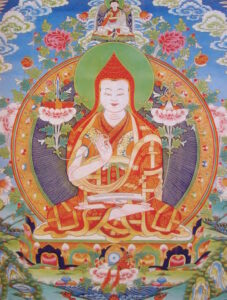 Patrul Rinpoche’s Advice on the Key Points of Dharma Practice
Patrul Rinpoche’s Advice on the Key Points of Dharma Practice
For the Gyalrong people Garwang and others who know little but have faith, here are some key instructions on how to practice Dharma.
Why are there people who wish to learn Dharma, but fail to practice it according to its teachings?
The reason is that they haven’t made a firm resolution within their hearts, so they are unsuccessful.
In those moments, you should make firm determinations.
Having met your good Dharma teacher, don’t believe other people’s words except the teacher’s.
You must act so, like a madman, not being able to listen to what others say.
In the beginning, tame your mindstream through the four preliminary practices (ngondro) and the four mind-changers.
Afterwards, realize that all activities in samsara and all mental states, such as those of joy and pain, are utterly meaningless, like a patient with gallbladder disease feeling disgusted with greasy food.
Without such renunciation, if you only feel an incidental impulse to renounce the world and hastily abandon worldly life, no longer engaging in your worldly responsibilities, in the end, it will be like a yak squeezing through a window — its head may go through, but its body remains trapped; this is a fruitless endeavor.
Also, there may be some senior practitioners having regressions in their motivation and meditation, maintaining an attachment to worldly life.
Therefore, you must contemplate the preliminary four mind changers until they completely integrate into the depths of your heart.
Before your mind is able to let go, you should not speak Dharma rashly or act rashly, and most importantly, do not abandon your family and children hastily.
Once renunciation arises in your heart, making you tired of samsara, giving you unwavering devotion in Dharma, and giving rise to self-confidence like the shameless vajra, only then, can you formally separate from enemies and loved ones, abandon farming, and decisively leave all unfinished business behind.
You must disregard the tethers of affection with relatives, friends, and spouses, and ignore the advice of elders and close friends to firmly resolve by yourself.
You must be like a bull with its nose rope wrapped around its own neck, uncontrolled by others, or like a wild horse broken free from its reins, never looking back. It must be done to such an extent.
In the main part of practice, the body and speech are servants, and what you do with them is of little use; the mind is the master, and your cultivation of it will make a big difference.
In Dharma practice, taking refuge and generating bodhicitta are the roots.
Without the roots, the tree of discipline cannot grow; without the tree, the flowers of view and meditation cannot bloom; without the flowers, the fruit of the generation and completion stages cannot ripen.
Therefore, refuge and bodhicitta are the root of all Dharma practices and are extremely important.
These two are also the root of all 84,000 Dharma methods and the nine vehicles, so they are the basis, the heart essence, the main pillar, and the life force.
Practices unrelated to these two are like dead carcasses or wreckage — utterly useless.
These two can be explained in great detail, but in summary, having deep faith and firm resolve in the Three Jewels in your heart, perceiving countless sentient beings as your own parents, and aspiring to bring them to both the common benefits of humans and devas, as well as the uncommon, ultimate benefit of Buddhahood are the explanation of refuge and bodhicitta.
But how to practice these two?
You must not be attached to the superficial knowledge of words, but seek the true practice, so you must follow a good spiritual teacher.
After having some achievements by following a spiritual teacher, continue on to learning guru yoga, Phowa, the shortcut path, and the rapid methods.
If you can understand this, you should exert great efforts in practice after receiving the empowerments.
If not, then just recite the Six-Syllable Mantra with kindness in your heart on the basis on refuge and bodhicitta will be fine.
To sum up, Dharma practice requires diligence and dedication, even putting aside your own life.
Otherwise, even if you know the teachings of the nine vehicles, you won’t attain Buddhahood.
However, anyone who has heard the name of the Three Jewels can attain Buddhahood in the future.
All of the above must be known in detail.
Written by the monk of Śrī Siṃha College, Pelge (Patrul Rinpoche) Translated by Lama Tsering Phuntsok, in retreat in Kaohsiung Recorded by the disciples assisting the retreat 1998/10/24
Chinese version 巴竹法王提點修行關要 Facebook link
